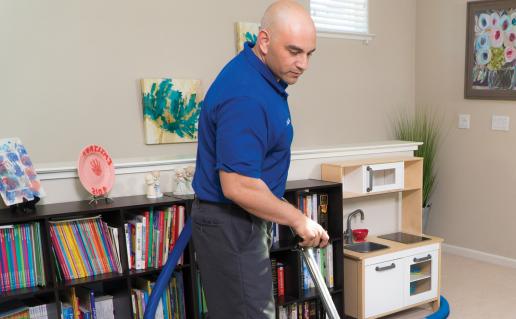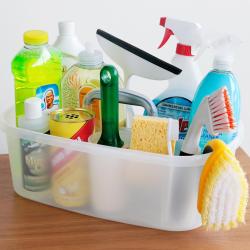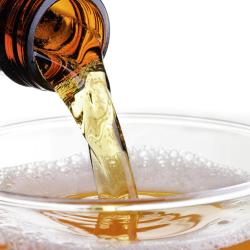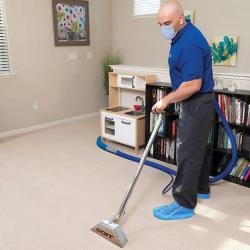Grease Stain Removal
The word “grease” brings a couple of images to mind.
- The famous musical/movie starring John Travolta and Olivia Newton-John.
- The marks you have on your hands when you frantically check your smoking engine.
- The drippings that result from last night’s delicious dinner.
Though we could go on for days about the famous legacy that number one has left on American musicals, the type of grease we’ll be looking at here refers to number two and number three: machinery grease and cooking grease.
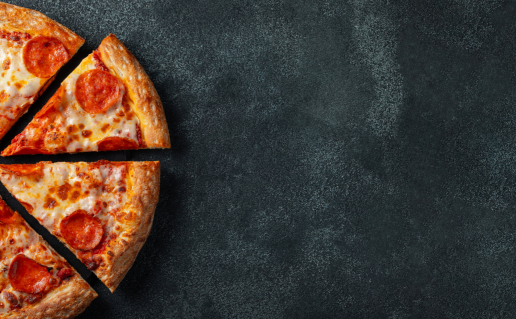
What is Machinery Grease?
According to the American Society for Testing and Material (ASTM), this machinery grease (also known as lubricating grease) is defined as: "A solid to semi fluid product of dispersion of a thickening agent in liquid lubricant. Other ingredients imparting special properties may be included."
Chemical Components of Machinery Grease
There are three major components in grease which cause the grease stains:
- Oil
- Thickener
- Additives
The thickener holds the lubricant together, while the base oil and additives function as the major components of the grease. When this base oil is exposed to extreme temperatures, whether it’s a high or low temperature, grease that contains synthetic base oil generally provides better performance when used with industrial machinery.
Grease Stains: What’s In ‘Em?
When it comes to thickeners in grease stains, metallic soap is the type that’s most commonly found in machinery grease. More specifically, these soaps include:
- Polyurea
- Aluminum
- Calcium
- Sodium
- Lithium
Additives are included in grease to enhance positive properties and mask undesirable properties. When you look at grease stains, chances are you’re looking at grease that contains one of these five types of additives:
- Antiwear
- Rust inhibitors
- Oxidation
- Extreme pressure
- Friction-reducing agents
So when you’re attempting to remove grease stains from any surface, you’re actually removing much more than grease; you’re removing a combination of chemicals that are mixed together to achieve one function, as noted on engineersedge.com: “the function of grease is to remain in contact with and lubricate moving surfaces without leaking out under gravity or centrifugal action, or be squeezed out under pressure.”
That’s apparently what you’re supposed to do when someone asks you to “put a little elbow grease into it!”
What is Cooking Grease?
When it comes time to remove grease stains, you probably will encounter some cooking grease in your home as well. Have you ever noticed that when you attempt do-it-yourself grease stain removal, it actually makes it even stickier?
One of the most common places that grease splashes is on the stovetop. This can be dried oil that splashes on your stovetop and then dries, which will undoubtedly leave a mark. To tackle grease stain removal in your kitchen, try these methods.
White Vinegar
- Take some white vinegar and pour it into a spray bottle.
- Let the vinegar soak into the grease for a few minutes, then wipe the stain with a towel soaked in hot water.
This should solve your grease stain removal issues in a matter of minutes.
Baking Soda Scrub - removing grease stains from carpet
Another grease stain removal technique to try on your kitchen’s stovetop involves using baking soda scrub. Take a damp kitchen sponge and cover it with a bit of baking soda. The baking soda isn’t harmful to your stove, and should gradually break up the grease stains.
For more detailed do-it-yourself methods to tackle grease stains at home, check out COIT’s guide to removing grease stains from carpet, as well as upholstery.
How to Remove Grease Stains from Upholstery
COIT's Guide to Removing Grease Stains from Upholstery
After a long week of work, ordering a few pizzas and throwing on a movie can be just what the doctor ordered. But when grease stains from that delicious pizza end up on your couch, you’ll need a quick solution to keep your furniture in tip-top shape.
By following COIT’s guide to removing grease stains from upholstery, a few grease stains won’t ruin your furniture.
How to Remove Grease Stains from Upholstery – Method # 1
- The first thing to do when removing grease stains from upholstery is to scrape off any dried grease using a plastic utensil. If the grease stain is wet, blot any excess grease using a damp paper towel.
- Take a bit of baking soda and sprinkle it onto the stain. Make sure the stain is completely covered.
- Let the baking soda absorb the grease from the upholstery for 15 to 20 minutes.
- Using a vacuum cleaner with a brush attachment, vacuum the baking soda off of the affected area.
- Take dry-cleaning solvent (such as Afta) and dampen a cloth with it. Press the cloth onto the grease stain.
- If you can still see grease residue, repeat steps 1 through 5 until the grease stain disappears. Though in most cases, this method should answer the question of how to remove grease stains from furniture.
Up to 50% off Residential cleaning services - Find discounts in your area!
How to Remove Grease Stains from Furniture – Method # 2
Another way to tackle the question of how to get grease stains out of upholstery involves using baby powder. Follow these steps below:
- Upon discovering the grease stain on your furniture, place a good amount of baby powder directly on the stain. Be sure to cover the stained area entirely, as this will help absorb the grease, pulling it out of the fabric.
- After a few minutes, brush off the stain, removing any excess baby powder. Repeat step 1 again.
- Next, take a scrub brush and work a generous amount of upholstery cleaner into the affected area. This will help break up the grease stain and is very helpful when wondering how to remove grease stains from upholstery.
- Pour a bit of liquid dish soap (a brand with grease-cutting abilities works best) onto a clean cloth and work this solution into the grease stain.
- Dab the grease stain with a damp cloth continuously.
- If you still see the stain, repeat steps 1 through 5 as necessary until the grease stain is no longer visible.
Removing Grease Stains from Upholstery – Method # 3
And yes, there is actually another do-it-yourself solution that answers the question of how to get grease stains out of upholstery. This method of cleaning grease stains involves multiple ingredients.
- First, cover the grease stain with a bit of mild dish soap and let it sit for a few minutes.
- Using a damp cloth, rinse the affected area of the upholstery with a bit of warm water.
- Next, mix equal parts water and ammonia together. Apply this solution, using a fresh sponge, directly on the grease stain.
- Scrub the affected area.
- Take one baby wipe and scrub the stain. The alcohol in the baby wipe helps remove the grease.
- If the grease stain is still lingering, dip a fresh cloth in some water and 3% hydrogen peroxide. Scrub the stain to try and lift any remaining grease.
So when it’s time to attack the problem of how to get grease stains out of upholstery, one of these three methods should help. And if a few stubborn stains still seem to linger, consider COIT Upholstery Cleaning and take advantage of a wide range of professional deep cleaning services. Don't forget to check out our coupons!
Remember to always do a spot removal test on a portion of carpet or upholstery that is normally not visible. These are suggested treatments only and COIT can't be held accountable for any damage sustained by the use of the treatments in this spot removal guide.
How to Remove Grease Stains from Carpet
How to Remove Grease Stains from Carpet
When you’re walking barefoot on your carpet and you encounter any kind of stain, you’ll probably want to get rid of it as fast as possible, right? When that stain happens to be a grease stain, you’ll definitely need an effective do-it-yourself method to turn to at home.
With Coit’s guide to removing grease stains from carpet, an unexpected grease stain won’t stop you in your tracks.
How to Remove Grease Stains from Carpet – Method # 1
Whether you encounter cooking grease or machinery grease that needs to be removed, this method is something you can do when removing grease stains from carpet.
- Blot up as much of the grease stain as possible; you’ll then want to apply a substance like cornmeal since it acts as an absorbent.
- Take a brush with stiff bristles and brush the stain to break it up.
- If the grease is still visible, apply a dry-cleaning solvent (Afta Cleaning Fluid is a good one to try) using a clean sponge.
- Apply a dry spotter to the stained area. A dry spotter is made by combining 8 parts liquid dry-cleaning solvent and 1-part coconut oil. Mineral oil, though not as effective, can also be substituted for coconut oil.
- Using an absorbent pad, cover the stain with a more dry spotter.
- As the pad continues to pick up the stain, you’ll see that this answers the question of how to remove grease stains from carpet.
Trouble removing your stain? Find discounts in your area - Limited time only!
How to Get Grease Out of Carpet – Method # 2
Another way to tackle the task of how to remove grease stains from carpet involves using white vinegar.
- Using a bit of water, sponge the stain.
- Apply a few drops of white vinegar, along with a wet spotter. A wet spotter is made of one part dishwashing detergent, one part glycerine, and eight parts water (shake it well and store in a plastic water bottle).
- Pour a generous amount of wet spotter onto an absorbent pad. Place the pad directly onto the grease stain.
- Change the absorbent pad as the grease stain gradually disappears.
- You can repeat steps 1 through 3, flushing the grease stain with water.
So the next time you encounter a grease stain, either from cooking or from your car, don’t sweat it. How to get grease out of carpet is a problem you can tackle with a few do-it-yourself remedies.
For more in-depth carpet cleaning that offers professional equipment and trained technicians, call COIT Cleaning today to learn about our satisfaction guarantee. Don't forget to check out our coupons!
Remember to always do a spot removal test on a portion of carpet or upholstery that is normally not visible. These are suggested treatments only and COIT can't be held accountable for any damage sustained by the use of the treatments in this spot removal guide.





